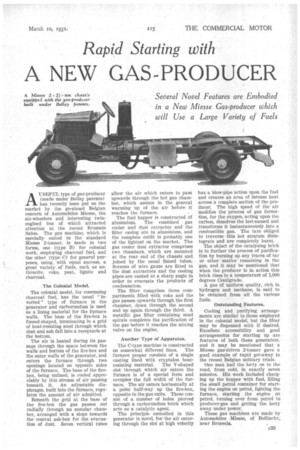Rapid Starting with
Page 61

If you've noticed an error in this article please click here to report it so we can fix it.
A NEW GAS-PRODUCER
AUSEFUL type of gas-producer (made under Bella.y patents) has recently been put on the market by the go-ahead Belgian concern of Automobiles Miesse, the six-wheelers and interesting twinengined bus of which attracted attention at the recent Brussels Salon. The gas machine, which is specially suited to the standard Miesse 2-tanner, is made in two forms, one (type B) for colonial work, employing charcoal fuel, and the other (type C) for general purposes, using, with equal success, a great variety of fuels, such as anthracite, coke, peat, lignite and charcoal.
The Colonial Model.
The colonial model, for consuming charcoal fuel, has the usual " inverted " type of furnace in the generator and carborunduna is used as a lining material for the furnace walls. The base of the fire-box is funnel-shaped, terminating in a grid of heat-resisting steel through which dust and ash fall into a receptacle at the bottom.
The air is heated during its passage through the space between the walls and bottom of the fire-box and the outer walls of the generator, and enters the furnace through two openings located on opposite sides of the furnace. The base of the firebox, being unlined, is cooled appreciably by this stream of air passing beneath it. An adjustable diaphragm, built into the furnace, regulates the amount of air admitted.
Beneath the grid at the base of the fire-box the gas passes out radially through an annular chamber, arranged with a slope towards the central ash-box for the evacuation of dust. Seven vertical tubes allow the air which enters to pass upwards through the hot gas chamber, which assists in the general warming up of the air before it reaches the furnace.
The fuel hopper is constructed of aluminium. The combined gas cooler and dust extractor and the filter casing are in aluminium, and the complete outfit is probably one of the lightest on the market. The gas cooler dust extractor comprises two chambers, which are mounted at the rear end of the chassis and joined by the usual finned tubes. Screens of wire gauze are fitted in the dust extractors and the cooling pipes are canted at a sharp angle in order to evacuate the products of condensation.
The filter comprises three compartments filled with coke and the gas passes upwards through the first chamber, down through the second and up again through the third. A metallie gas filter containing steel spirals completes the purification of the gas before it reaches the mixing valve on the engine.
Another Type of Apparatus.
The C-type machine is constructed on somewhat different lines. The furnace proper consists of a single casting lined with cryptalon heat resisting material. The V-shaped slot through which air enters the furnace is of a special form and occupies the full width of the furnace. The air enters horizontally at a point half-way up the fire-box, opposite to the gas exits. These consist of a number of holes pierced through a carborundum brick which acts as a catalytic agent.
The principle embodied in this generator is novel, for the air entering through the slot at high velocity has a blow-pipe action upon the fuel and creates an area of intense heat across a complete section of the producer. The high speed of the air modifies the process of gas formation, for the oxygen, acting upon the carbon, dissolves the last-named and transforms it instantaneously into a combustible gas. The tars obliged to traverse this hot stratum disintegrate and are completely burnt.
The object of the catalyzing brick is to further the process of purification by burning up any traces of tar or other matter remaining in the gas, and it may be mentioned that when the producer is in action this brick rises to a temperature of 1,000 degrees Centigrade.
A gas of uniform quality, rich in hydrogen and methane, is said to be obtained from all the various fuels.
Outstanding Features.
Cooling and purifying arrangements are similar to those employed in the colonial model, but the filter may be dispensed with if desired. Excellent accessibility and good arrangements for starting up are features of both these generators, and it may be mentioned that a Miesse gas-driven 2-tonner gave a good example of rapid get-away in the recent Belgian military trials.
One man had the lorry an to the road, from cold, in exactly seven minutes. His work included charging up the hopper with fuel, filling the small petrol container for starting the engine on petrol, lighting the furnace, starting the engine on petrol, turning over from petrol to producer-gas and getting the lorry away under power.
These gas machines are made by Automobiles Miesse, of Bollinckx, near Brussels.












































































































